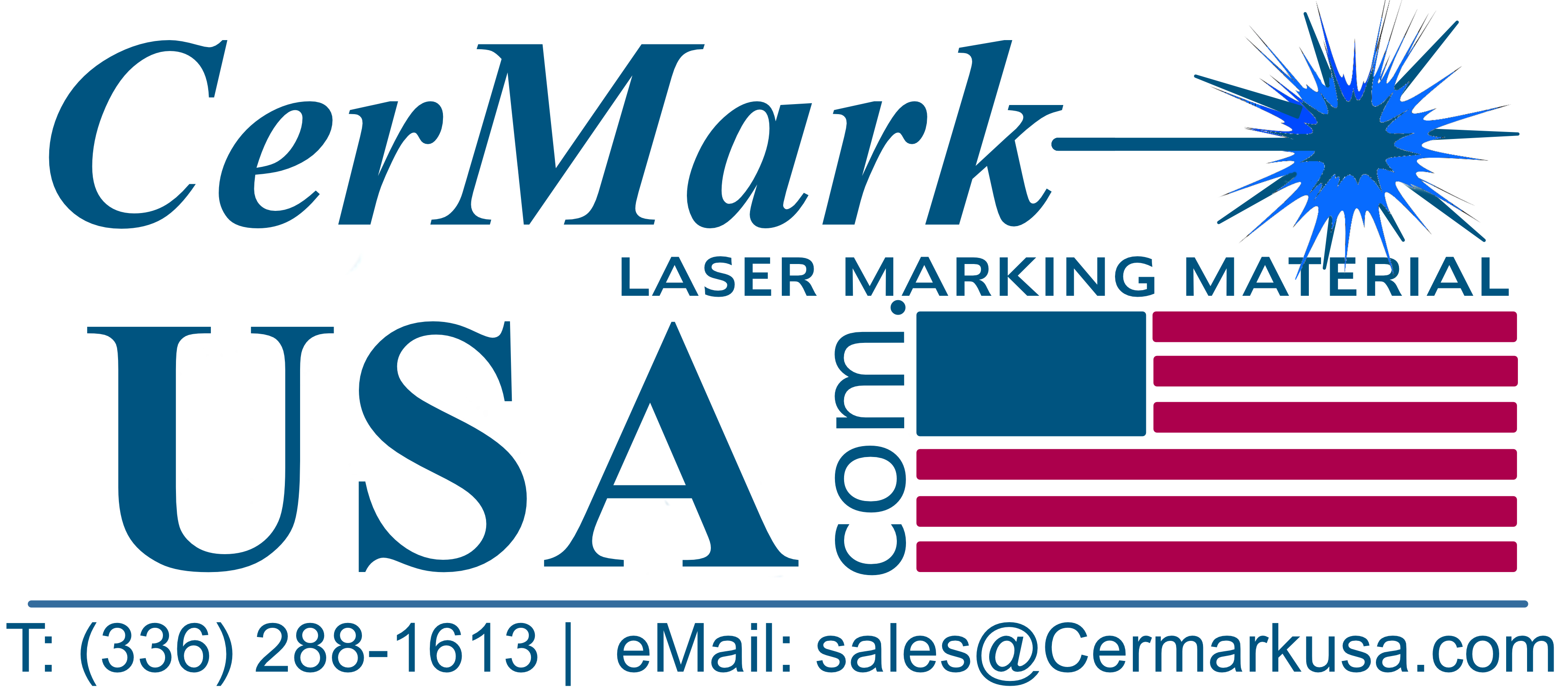Application
Clean the surface to be marked (all products)
No matter which product and supply form you choose, the process of bonding between laser marking material and substrate occurs at a molecular level so it is important the substrate be free of all kinds of contamination such as oil, debris or coatings. Consequently, the substrate should be thoroughly cleaned before application of CerMark laser marking material: the quality of your mark strongly depends on the cleanliness of the substrate prior to material application. Depending on the substrate, it should be cleaned with a solvent such as alcohol or rinsed with soap and water and completely dried. Be careful not to use a cleaning agent that leaves a residue behind.
Foam Brush Application
 Most CerMark laser marking materials come as liquid or paste ink in a variety of container sizes. Depending on the application and the industrial setting a regular foam brush can be an easy choice for ink application. To apply the ink soak the foam brush less than 1/4th of its length (less than 0.25”) into the container. There is no need to soak more than that, otherwise the ink may splash and result in an uneven coat thickness. Apply with smooth, even strokes. When applying ink with a foam brush the two most important variables to control are dilution and coat thickness.
Most CerMark laser marking materials come as liquid or paste ink in a variety of container sizes. Depending on the application and the industrial setting a regular foam brush can be an easy choice for ink application. To apply the ink soak the foam brush less than 1/4th of its length (less than 0.25”) into the container. There is no need to soak more than that, otherwise the ink may splash and result in an uneven coat thickness. Apply with smooth, even strokes. When applying ink with a foam brush the two most important variables to control are dilution and coat thickness.
Even after you have achieved the proper dilution for your product and begun applying the ink you should be on the look out for changes in viscosity. Since CerMark recommends diluting its inks with denatured alcohol, which can evaporate, an open container of CerMark ink may become more viscous over time due to evaporation of its thinning agent. This problem is easily overcome by adding a small additional amount of denatured alcohol and stirring continuously until the desired viscosity and homogeneity is recaptured.
The second major issue is coat thickness and consistency. Desired coating thickness varies by product and substrate so it is important to consult the individual page for your product for exact guidelines prior to application. Most of the time one or two coatings are enough, but for some substrates additional coats may be required. You will achieve better marks using our recommended coating thicknesses than simply applying more ink. If your material coating is too thick it will absorb too much laser energy and fail to bond to the substrate. If your material coating is too thin the pigment density of the material layer will not be high enough to create an optimal mark. It is important to realize that correct coat thickness is often even more important than the accuracy of laser settings for creating optimal marks.
After application, allow the applied marking material to dry. Unaided air drying typically requires several minutes. A fan, heat gun, or hair dryer can be used to accelerate the process to 10 seconds or less. It is important the marking material be completely dry prior to laser marking.
Aerosol Spray Application
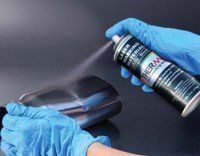 Three CerMark products are for sale as aerosol sprays,New Ultra, LMM14 and LMM6000. Aerosol cans attract many customers due to their relative ease of handling and stand alone nature. Both of these products are also available as liquid/paste ink, but aerosol cans have the added benefit of removing the variable of dilution. However, aerosol products still require some experimentation to learn the application process and generate reproducible and consistent results.
Three CerMark products are for sale as aerosol sprays,New Ultra, LMM14 and LMM6000. Aerosol cans attract many customers due to their relative ease of handling and stand alone nature. Both of these products are also available as liquid/paste ink, but aerosol cans have the added benefit of removing the variable of dilution. However, aerosol products still require some experimentation to learn the application process and generate reproducible and consistent results.
Shake the aerosol can thoroughly before use to achieve a homogenous suspension of marking material inside the can. Spray uniformly at a 10” distance from the surface and move the nozzle from one side to the other covering the whole substrate area. Start spraying away from the area to be marked and move towards the opposite side and past the target area. Over-spraying before and after the target area allows constant velocity of movement and will help provide an even coating on the substrate. As in all liquid/paste ink products, consistency in application process is important for the quality of the mark.
Again, desired coating thickness varies by product and substrate so it is important to consult the individual page for your product for exact guidelines prior to application. Generally, however, the optimal wet film layer thickness for metals is about 0.5 – 2 mils. As both aerosol products are for use on metal, one or two coatings are typically enough. You will achieve better marks using our recommended coating thicknesses than simply applying more ink. If your material coating is too thick it will absorb too much laser energy and fail to bond to the substrate. If your material coating is too thin the pigment density of the material layer will not be high enough to create an optimal mark. It is important to realize that correct coat thickness is often even more important than the accuracy of laser settings for creating optimal marks.
Allow the applied marking material to dry. Unaided air drying typically requires several minutes. A fan, heat gun, or hair dryer can be used to accelerate the process to 10 seconds or less.
A note on safety: All aerosol sprays represent airborne liquid droplets and solid particles. During the spraying process this matter “floats” in the air. You should exercise the same precautions you would working with any kinds of aerosol: use in a well-ventilated area or use a breathing mask, never spray towards yourself, and wear gloves.
Airbrush Spray Application
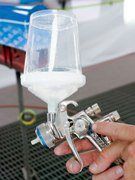 CerMark liquid/paste inks can be diluted to a viscosity appropriate for airbrushing. This method is preferable to foam brush application for any job larger than a few parts. In industrial settings, air brush application should be carried out in a spray booth with fume extraction, or, at minimum, in a well-ventilated area with a breathing mask.
CerMark liquid/paste inks can be diluted to a viscosity appropriate for airbrushing. This method is preferable to foam brush application for any job larger than a few parts. In industrial settings, air brush application should be carried out in a spray booth with fume extraction, or, at minimum, in a well-ventilated area with a breathing mask.
A standard air brush (such as Smart Jet from IWATA) generates good results, and you may customize your spray pattern by adjusting the nozzle of your air brush. Application considerations are the same as above in the Aerosol spray application section.
Self-Adhesive Tape
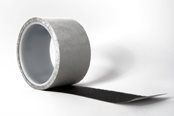 CerMark’s self-adhesive tape, LMM6018.LF, removes the variables of dilution and coating thickness during application, making it the easiest product to use. To apply, unroll a sufficient amount of tape to cover the surface area to be marked and stick it down carefully. It is important the tape have uniform contact with the substrate surface otherwise some areas may not bond properly during laser marking. Care should be taken to remove any air bubbles from under the tape: smoothing down gently with fingers should be adequate to remove air bubbles. If you wish to mark on a surface that is highly irregular with too many bumps or crevices, self-adhesive tape may not be appropriate because uniform tape to substrate contact may be impossible.
CerMark’s self-adhesive tape, LMM6018.LF, removes the variables of dilution and coating thickness during application, making it the easiest product to use. To apply, unroll a sufficient amount of tape to cover the surface area to be marked and stick it down carefully. It is important the tape have uniform contact with the substrate surface otherwise some areas may not bond properly during laser marking. Care should be taken to remove any air bubbles from under the tape: smoothing down gently with fingers should be adequate to remove air bubbles. If you wish to mark on a surface that is highly irregular with too many bumps or crevices, self-adhesive tape may not be appropriate because uniform tape to substrate contact may be impossible.
Pad Printing Ink
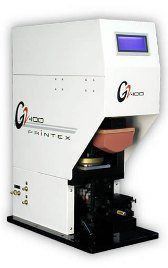 In a production environment, pad printing is a commonly used process for quickly and consistently applying a wet film of material over a relatively small area (approximately 6 square inches). CerMark has developed specially formulated materials which can easily “drop-in” to a standard pad printing process. The LMP500 inks are designed to deliver the appropriate thixotropy for pad printing and are conveniently packaged in small sizes which can be used to fill the pad printer’s ink cup without unnecessary mixing, dilution and wastage.
In a production environment, pad printing is a commonly used process for quickly and consistently applying a wet film of material over a relatively small area (approximately 6 square inches). CerMark has developed specially formulated materials which can easily “drop-in” to a standard pad printing process. The LMP500 inks are designed to deliver the appropriate thixotropy for pad printing and are conveniently packaged in small sizes which can be used to fill the pad printer’s ink cup without unnecessary mixing, dilution and wastage.
The ink cup of the pad printer should be completely filled with the CerMark material. The ink requires minimal mixing as this takes place during the normal printing process. The pad printer can then be used as normal with the appropriate mask for the image being printed. To avoid having to align the laser to the printed image, we normally recommend that a “block” of material is printed on the part. The laser is then used to bond the exact graphic image; following this, the excess materials are easily washed away using an appropriate washing agent.
To ensure the correct wet film thickness, it may be necessary to do multiple passes with the pad printer, depending on the substrate and darkness of mark required. This is easily achievable due to the fast drying times of the ink.
Because of the nature of pad printing inks, CerMark recommends that excess materials are removed from the part using a Brulin Safety Clean solvent. For cleaning the equipment and tooling between shifts, there is also a recommended thinner which can be purchased from CerMark.
